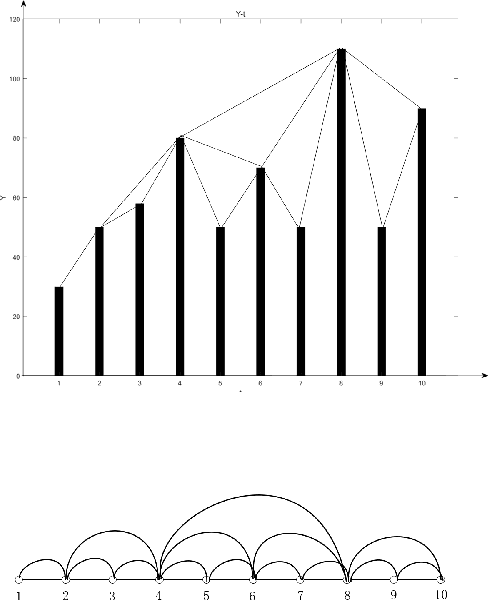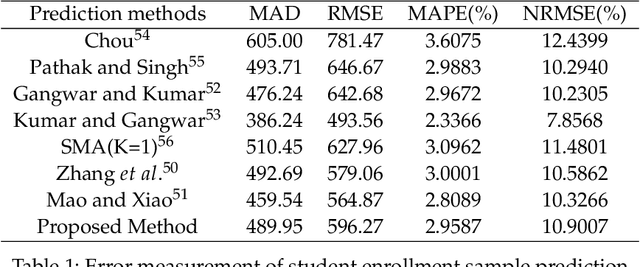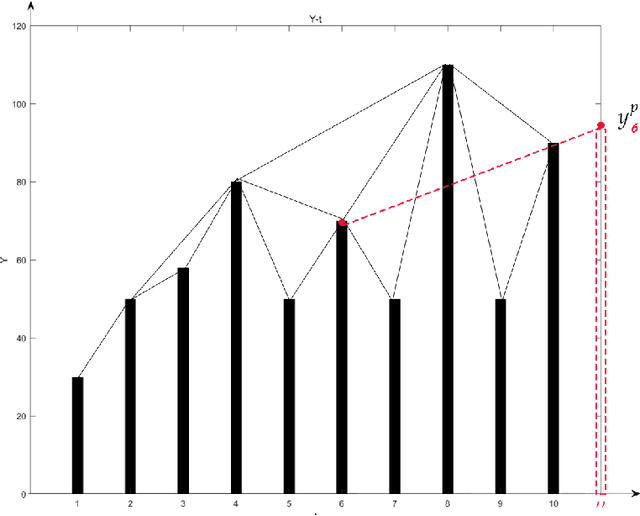Fuyuan Xiao
A New Quantum Dempster Rule of Combination
Apr 28, 2023Abstract:Dempster rule of combination (DRC) is widely used for uncertainty reasoning in intelligent information system, which is generalized to complex domain recently. However, as the increase of identification framework elements, the computational complexity of Dempster Rule of Combination increases exponentially. To address this issue, we propose a novel quantum Dempster rule of combination (QDRC) by means of Toffoli gate. The QDRC combination process is completely implemented using quantum circuits.
DVS: Deep Visibility Series and its Application in Construction Cost Index Forecasting
Nov 07, 2021



Abstract:Time series forecasting has always been a hot spot in scientific research. With the development of artificial intelligence, new time series forecasting methods have obtained better forecasting effects and forecasting performance through bionic research and improvements to the past methods. Visibility Graph (VG) algorithm is often used for time series prediction in previous research, but the prediction effect is not as good as deep learning prediction methods such as Artificial Neural Network (ANN), Convolutional Neural Network (CNN) and Long Short-Term Memory Network (LSTM) prediction. The VG algorithm contains a wealth of network information, but previous studies did not effectively use the network information to make predictions, resulting in relatively large prediction errors. In order to solve this problem, this paper proposes the Deep Visibility Series (DVS) module through the bionic design of VG and the expansion of the past research, which is the first time to combine VG with bionic design and deep network. By applying the bionic design of biological vision to VG, the time series of DVS has obtained superior forecast accuracy, which has made a contribution to time series forecasting. At the same time, this paper applies the DVS forecasting method to the construction cost index forecast, which has practical significance.
Construction Cost Index Forecasting: A Multi-feature Fusion Approach
Aug 18, 2021



Abstract:The construction cost index is an important indicator in the construction industry. Predicting CCI has great practical significance. This paper combines information fusion with machine learning, and proposes a Multi-feature Fusion framework for time series forecasting. MFF uses a sliding window algorithm and proposes a function sequence to convert the time sequence into a feature sequence for information fusion. MFF replaces the traditional information method with machine learning to achieve information fusion, which greatly improves the CCI prediction effect. MFF is of great significance to CCI and time series forecasting.
Uncertainty Measurement of Basic Probability Assignment Integrity Based on Approximate Entropy in Evidence Theory
May 18, 2021



Abstract:Evidence theory is that the extension of probability can better deal with unknowns and inaccurate information. Uncertainty measurement plays a vital role in both evidence theory and probability theory. Approximate Entropy (ApEn) is proposed by Pincus to describe the irregularities of complex systems. The more irregular the time series, the greater the approximate entropy. The ApEn of the network represents the ability of a network to generate new nodes, or the possibility of undiscovered nodes. Through the association of network characteristics and basic probability assignment (BPA) , a measure of the uncertainty of BPA regarding completeness can be obtained. The main contribution of paper is to define the integrity of the basic probability assignment then the approximate entropy of the BPA is proposed to measure the uncertainty of the integrity of the BPA. The proposed method is based on the logical network structure to calculate the uncertainty of BPA in evidence theory. The uncertainty based on the proposed method represents the uncertainty of integrity of BPA and contributes to the identification of the credibility of BPA.
A Fast Evidential Approach for Stock Forecasting
Apr 12, 2021



Abstract:In the framework of evidence theory, data fusion combines the confidence functions of multiple different information sources to obtain a combined confidence function. Stock price prediction is the focus of economics. Stock price forecasts can provide reference data. The Dempster combination rule is a classic method of fusing different information. By using the Dempster combination rule and confidence function based on the entire time series fused at each time point and future time points, and the preliminary forecast value obtained through the time relationship, the accurate forecast value can be restored. This article will introduce the prediction method of evidence theory. This method has good running performance, can make a rapid response on a large amount of stock price data, and has far-reaching significance.
Time series forecasting based on complex network in weighted node similarity
Mar 26, 2021



Abstract:Time series have attracted widespread attention in many fields today. Based on the analysis of complex networks and visibility graph theory, a new time series forecasting method is proposed. In time series analysis, visibility graph theory transforms time series data into a network model. In the network model, the node similarity index is an important factor. On the basis of directly using the node prediction method with the largest similarity, the node similarity index is used as the weight coefficient to optimize the prediction algorithm. Compared with the single-point sampling node prediction algorithm, the multi-point sampling prediction algorithm can provide more accurate prediction values when the data set is sufficient. According to results of experiments on four real-world representative datasets, the method has more accurate forecasting ability and can provide more accurate forecasts in the field of time series and actual scenes.
Generalized Belief Function: A new concept for uncertainty modelling and processing
Jul 03, 2019Abstract:In this paper, we generalize the belief function on complex plane from another point of view. We first propose a new concept of complex mass function based on the complex number, called complex basic belief assignment, which is a generalization of the traditional mass function in Dempster-Shafer evidence theory. On the basis of the de nition of complex mass function, the belief function and plausibility function are generalized. In particular, when the complex mass function is degenerated from complex numbers to real numbers, the generalized belief and plausibility functions degenerate into the traditional belief and plausibility functions in DSE theory, respectively.
Evidential distance measure in complex belief function theory
Jun 27, 2019
Abstract:In this paper, an evidential distance measure is proposed which can measure the difference or dissimilarity between complex basic belief assignments (CBBAs), in which the CBBAs are composed of complex numbers. When the CBBAs are degenerated from complex numbers to real numbers, i.e., BBAs, the proposed distance will degrade into the Jousselme et al.'s distance. Therefore, the proposed distance provides a promising way to measure the differences between evidences in a more general framework of complex plane space.
Generalization of Dempster-Shafer theory: A complex belief function
Jun 27, 2019


Abstract:Dempster-Shafer evidence theory has been widely used in various fields of applications, because of the flexibility and effectiveness in modeling uncertainties without prior information. However, the existing evidence theory is insufficient to consider the situations where it has no capability to express the fluctuations of data at a given phase of time during their execution, and the uncertainty and imprecision which are inevitably involved in the data occur concurrently with changes to the phase or periodicity of the data. In this paper, therefore, a generalized Dempster-Shafer evidence theory is proposed. To be specific, a mass function in the generalized Dempster-Shafer evidence theory is modeled by a complex number, called as a complex basic belief assignment, which has more powerful ability to express uncertain information. Based on that, a generalized Dempster's combination rule is exploited. In contrast to the classical Dempster's combination rule, the condition in terms of the conflict coefficient between the evidences K<1 is released in the generalized Dempster's combination rule. Hence, it is more general and applicable than the classical Dempster's combination rule. When the complex mass function is degenerated from complex numbers to real numbers, the generalized Dempster's combination rule degenerates to the classical evidence theory under the condition that the conflict coefficient between the evidences K is less than 1. In a word, this generalized Dempster-Shafer evidence theory provides a promising way to model and handle more uncertain information.
Multi-sensor data fusion based on a generalised belief divergence measure
Jun 05, 2018



Abstract:Multi-sensor data fusion technology plays an important role in real applications. Because of the flexibility and effectiveness in modelling and processing the uncertain information regardless of prior probabilities, Dempster-Shafer evidence theory is widely applied in a variety of fields of information fusion. However, counter-intuitive results may come out when fusing the highly conflicting evidences. In order to deal with this problem, a novel method for multi-sensor data fusion based on a new generalised belief divergence measure of evidences is proposed. Firstly, the reliability weights of evidences are determined by considering the sufficiency and importance of the evidences. After that, on account of the reliability weights of evidences, a new Generalised Belief Jensen-Shannon divergence (GBJS) is designed to measure the discrepancy and conflict degree among multiple evidences, which can be utilised to measure the support degrees of evidences. Afterwards, the support degrees of evidences are used to adjust the bodies of the evidences before using the Dempster's combination rule. Finally, an application in fault diagnosis demonstrates the validity of the proposed method.
 Add to Chrome
Add to Chrome Add to Firefox
Add to Firefox Add to Edge
Add to Edge